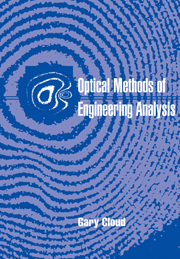Book contents
- Frontmatter
- Contents
- Acknowledgments
- 1 Introduction and orientation
- Part I Optics and interferometry
- Part II Photoelasticity
- Part III Geometrical moire
- Part IV Diffraction theory, optical processing, and moire
- Part V Moire interferometry
- 13 Principles of moire interferometry
- 14 A moire interferometer
- 15 Experimental methods in moire interferometry
- Part VI Holographic interferometry
- Part VII Speckle methods
- Author index
- Subject index
13 - Principles of moire interferometry
Published online by Cambridge University Press: 12 January 2010
- Frontmatter
- Contents
- Acknowledgments
- 1 Introduction and orientation
- Part I Optics and interferometry
- Part II Photoelasticity
- Part III Geometrical moire
- Part IV Diffraction theory, optical processing, and moire
- Part V Moire interferometry
- 13 Principles of moire interferometry
- 14 A moire interferometer
- 15 Experimental methods in moire interferometry
- Part VI Holographic interferometry
- Part VII Speckle methods
- Author index
- Subject index
Summary
In this part, a moire method that combines the concepts of the moire effect, diffraction by a grating, and two-beam interference is described. The method is truly interferometric, and it is capable of high sensitivity. This chapter develops the theory.
Concept and approach
The preceding chapters have discussed two approaches for utilizing the moire effect in measurement of displacements, rotations, and strain. There is yet a third approach for performing moire measurements. It utilizes the fundamental concept of the moire effect, the concept of diffraction by a grating, and the phenomenon of two-beam interference to extend the capability and utility of moire measurement far beyond the limitations of geometric moire. It shares some basic ideas with intermediate sensitivity moire, which uses optical processing; but it bypasses the limitations imposed by the necessity to optically image the gratings. The result is a moire technique that is capable of truly interferometric sensitivities. That is, the wavelength of light is the metric, and displacements of fractions of 1 μm can be measured. This technique is finding increasing favor with experimentalists doing research in material characterization, fracture, and other areas for which high sensitivity is needed but other interferometric techniques are not suitable.
Moire interferometry can be modeled as a physical process in two distinct ways, and valuable insights are to be gained from each model. Before getting into the details of this powerful technique, which necessarily involve intricate geometric visualization, let us examine briefly these two physical models.
On the one hand, moire interferometry can be viewed strictly as a process involving two-beam interference and diffraction, and nothing needs to be said about the moire effect.
- Type
- Chapter
- Information
- Optical Methods of Engineering Analysis , pp. 269 - 312Publisher: Cambridge University PressPrint publication year: 1995
- 1
- Cited by

